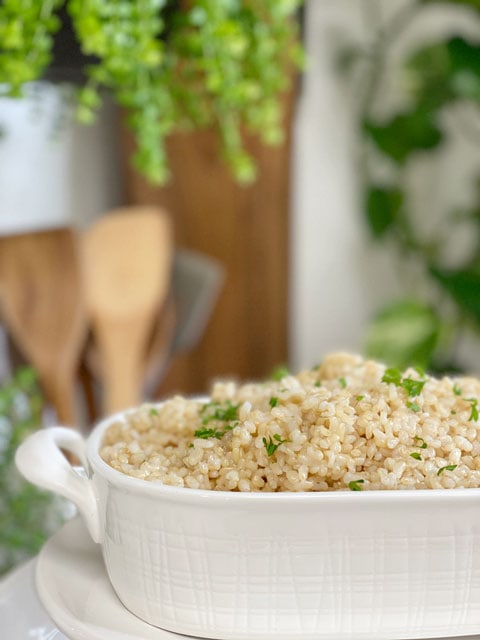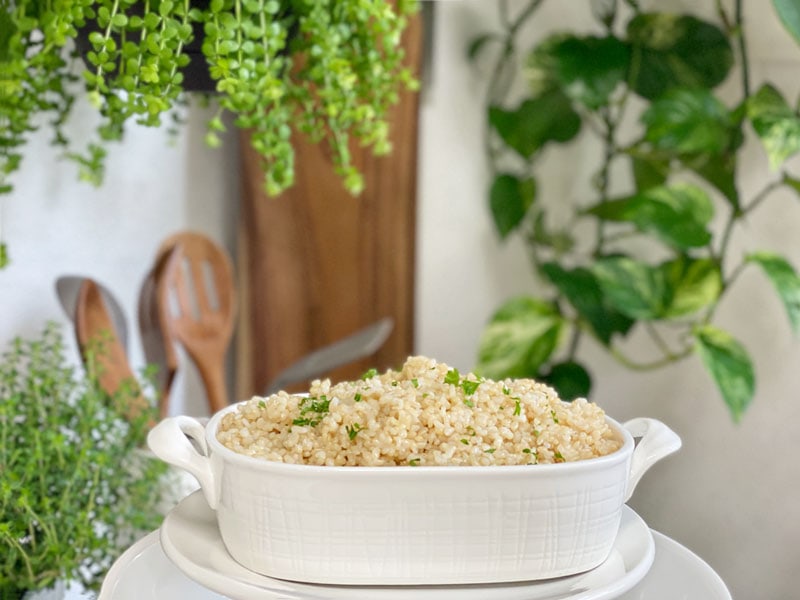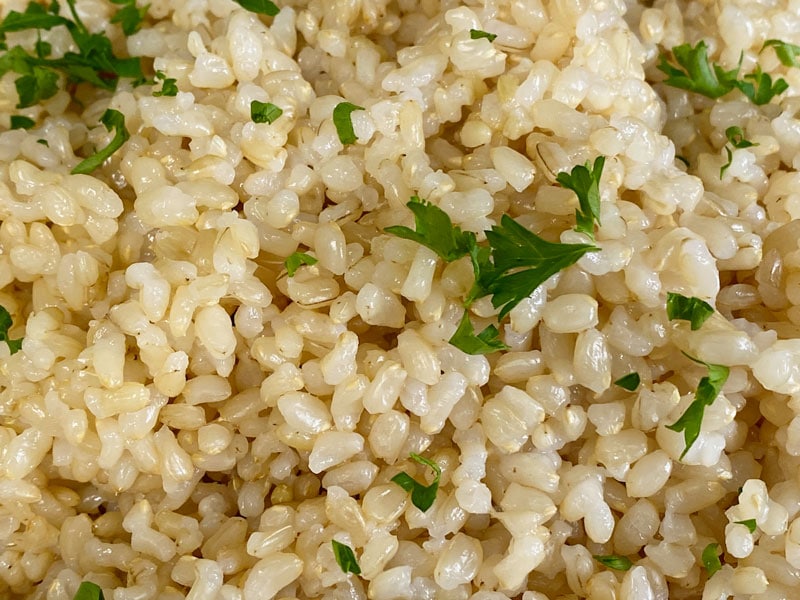


 Add to favorites
Add to favorites
Being prepared for the week leads to less stress–a perfect tool is batch cooking! It’s perfect for busy weeknights and easy meal prep. A container of unseasoned prepared brown rice can become the foundation for many meals. Enjoy alongside steamed vegetables, add it to your burritos and salads, and so much more. You can even turn it into a dessert by adding a splash of your favorite plant-based milk, a touch of sweetener, and a dash of cinnamon. Delicious!

You don’t have to use an Instant Pot to make rice, BUT doing so cuts the cooking time in half. Set it and forget it; no need to tend the pot. No more uncooked, burnt, or mushy brown rice!
If you want perfectly separate grains, rinsing it first helps to remove the thin layer of starch from the surface of each grain, which helps keep the rice from sticking together. You can also add a tablespoon of oil to the pot when cooking. I found that the addition of kombu seaweed helped to create not-so-sticky rice.
Kombu is a type of sea kelp that is rich in vitamins and minerals, including potassium, calcium, and iodine. It is a great ingredient to keep stashed in your pantry, as it is a tasty addition to soups and salads, and makes beans and grains more digestible when added to the cooking water.
It has a very mild flavor, not one that you would expect from a seaweed. It has a saltiness that comes from a balanced, chelated combination of sodium, potassium, calcium, phosphorus, magnesium, iron, and a myriad of trace minerals found in the ocean. So next time you make a pot of rice, grains, soup, vegetable broth, or beans, add a strip into the pot and reap the nutritional benefits of seaweed.
Important Note – Kombu can be eaten if you want the added nutrition. Just dice it up and stir it into your dish. You can also save it in the fridge after the rice has cooked and reuse it a couple of times before tossing it. I have a post that you can view (here) if you want to learn more.

I am all about making every bite count when I prepare food, hence why I add the kombu as well as soaking my rice overnight before cooking it. In general, soaking any type of grain before cooking renders its nutrients more digestible by breaking down and neutralizing phytic acid, which is an anti-nutrient that prevents the absorption of calcium, zinc, and other minerals. You can skip this step, but your nutritional outcome will be better if you soak.
As far as measurements go, you can adjust them to meet your family’s needs. Just keep the rice to water ratio 1:1. Should you decide to double or triple this recipe, the cooking time doesn’t change. However, the overall time will be longer when you prepare a larger quantity because it will take longer for the pot to come to pressure when compared to a smaller quantity of rice.
The maximum amount you can cook at one time will depend on the size pot you have. I use an 8-quart; therefore, the max I cook is 3 cups of rice and 3 cups water. The reason for this is because rice creates foamy, starchy water as it cooks, and you don’t want it to rise too high during the cooking cycle and damage your pot.
 Ingredients
IngredientsYields 6 cups cooked rice
When it comes to storing hot foods, we have a 2-hour window. You don’t want to put piping hot foods directly into the refrigerator. However, If you leave food out to cool, and forget about it you should, after 2 hours, throw it away to prevent the growth of bacteria. (source) Large amounts should be divided into smaller portions and put in shallow, covered containers for quicker cooling in a refrigerator that is set to 40 degrees (F) or below.
Hi Amie Sue !
I hope you and your husband are doing well. I love your website and recipes.
I have a question about the Kombu seaweed you use. May I ask what brand do you use ?. I want to start using it when cooking rice or bean dishes and to be certain it is a safe and reputable company when it comes to using seaweed.
Thanks for your advice !
Stephanie A.
Good morning Stephanie,
We are doing well, thank you for asking. We are having some teaser snows right now, but I know spring isn’t too far away. Gearing things up for gardening. :) I use Maine Coast Kelp, Wild Atlantic Kombu, (whole plant, organic). I have been using them for… gosh, 10 years?! I hope you are doing well and so happy to hear that you are enjoying my site. blessings, amie sue